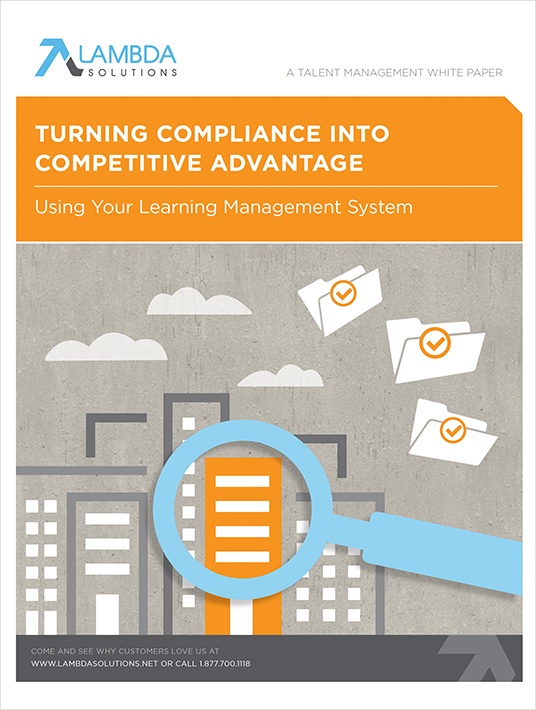Reducing The Increasing Compliance Burden With Online Compliance Training
Executive leaders view compliance as a prime risk and they are taking it seriously[1]. While organizations have always faced regulatory oversight and standards, current compliance environments in almost every industry are increasingly more onerous, more complex, and continuously shifting. It seems ironic, but the very systems we put in place to make workplaces safer and less prone to error have become the biggest source of corporate risk. The stakes have climbed too, with accrediting bodies and enforcement agencies becoming more aggressive and penalties increasing.

In highly regulated industries like Finance, Insurance, Healthcare, and Oil & Gas, many larger companies hire a dedicated compliance executive and a team that works to ensure requirements are met. Sophisticated governance, risk, and compliance software helps them assess and mitigate risk.
In small and mid-size organizations, C-level executives struggle to interpret regulations and turn them into business practices that meet requirements. And there’s a growing disconnect between business leaders’ confidence in their ability to manage regulatory compliance compared to the reality of keeping pace with evolving requirements.
For example, according to a recent ADP Research Institute survey[2], 30% of mid-sized companies surveyed reported expenses, including fines, lawsuits, or penalties, due to noncompliance with basic government workforce and payroll regulations alone.
These same firms were 80% sure they were able to meet requirements.

Credit: Lambda Solutions
Meeting quality, performance, and compliance goals requires a clear understanding of regulatory requirements, a talent development program that teaches people how to be compliant, and corporate strategic objectives that can take advantage of compliance requirements.
While many larger companies have adopted systems that allow them to manage compliance, develop talent and align individual performance with organizational objectives, mid-sized organizations can now benefit from integrated learning and talent management systems too.

Credit: Lambda Solutions
The Benefits Of Online Compliance Training
For companies that have state, provincial, or federal regulations such as PIPEDA in Canada, HIPPA in the US, FDA, and OSHA, or that follow quality standards such as ISO 9000/14000, it is essential to streamline training procedures, and monitor training effectiveness vis-à-vis compliance. In the financial industry, regulations such as Dodd-Frank, the Volcker rule, and Sarbanes-Oxley have created a need for specialized training so that employees can learn and apply best practices to streamline processes and meet regulatory demands.
Many companies have turned to online compliance training. Distributed workforces and the rise of mobility and telecommuting have made online learning an attractive alternate to costly face to-face sessions. In addition to cost reduction, online learning can improve course consistency, which for compliance training is very important. An online system can also track who has taken which courses toward certifications and provides a built-in audit trail.
Reducing The Risk Of Non-Compliance
The ideal system combines online learning with talent management so that compliance training can be linked directly to employee performance. A good talent management system will have features that allow you to monitor and assess each individual’s existing credentials and any progress towards new ones. This reduces the risk of non-compliance by monitoring training levels and maintaining accurate records as evidence of compliance. Alerts can let training managers or human resource professionals (as well as workers) know when credentials require renewal. The talent management system should show the worker exactly which course they need to take in order to keep their status, allowing them to obtain permission and register in the course they need all from one interface.
Audit Trails
If your organization has an accrediting body, they will want to see proof that your staff maintained credentials in order to be able to perform their job. The appropriate Learning Management System can help you produce the necessary reports without laborious manual processes or spreadsheet manipulations.
For mid-size organizations, the decision about whether to adopt a Learning Management System for compliance has become financially viable with the advent of hosted, open source solutions. As an added bonus, if you are going to use eLearning for compliance reasons you can use it for training of all kinds, and you can also get talent management functionality to integrate training with employee performance.
Aligning Performance With Corporate Strategy
If you have an online learning system that includes performance management, you can link training and performance and then you can align individual performance to corporate strategies. Nimble companies test and tune their corporate strategies on a regular basis. Strategies can alter to take advantage of external events, or to steer around potential obstacles. But, how do you make sure everyone on the team knows how the changes impact their work and personal development? Aligning talent development and corporate strategy is difficult. Often it seems the corporate goals are large, unwieldy and difficult to grasp at the department level – let alone at the individual level. The reality is that a 2014 study, Rethinking Performance Management, by The Corporate Executive Board, shows that the degree of alignment with corporate goals is woefully low. But it doesn’t have to be.

Credit: Lambda Solutions
In well-managed companies, line of business leaders identify how their unit can contribute to achieving the larger goals and then identify the roles and competencies required. While there are generic skills like time management, critical thinking, effective communications, and so forth, there are also specific competencies based on role. For each role, competencies, compliance certifications, as well as job performance appraisals and progress in the generic skills, can form the basis for a unique talent development program at the individual level.
When all these steps are taken, individuals can see exactly what they need to do next to achieve new levels of competency, or to bring their skills up to an acceptable level for compliance. With visibility into their performance and development path, employees can more easily steer their own career trajectory. Moreover, management can spot the high-flyers, or those who need help.
An integrated Learning and Talent Management System can aid in the following ways.
1. Career Path Definition
A manager needs to define a role associated with a goal, enter the skills and certifications required to fulfill that role only once. When a new hire is added, he or she is assigned a role and the system automatically populates their record with the skills, compliance and certification path they’ll need to follow to get to their next desired role – assuming it is within the same organization. By showing people directly what they need to do to get to the next level, they can make informed career decisions. For management, a well-defined and easily communicated career path, documented through the system, constitutes an auditable employment record. Because you can see who is working to improve their skills and cross-reference that with their actual performance, you can spot the high performers that your organization would want to foster and or promote over others.

Credit: Lambda Solutions
2. Workforce Performance Measurement
By keeping all employee information in one unified system, human resources professionals and other corporate leaders can view aggregate statistics regarding workforce performance. Because roles are associated with larger goals, you can find out which goals are most actively supported by training. Line of business managers can easily see when an important goal is lacking roles and associated training. Moreover, corporate leadership can see on aggregate whether the people in the organization are working effectively toward corporate goals.
3. Individual Contribution To Corporate Goals
The average employee working on their tasks might never understand how their projects contribute to larger corporate goals. With access to their record in an integrated learning and talent management system, employees can view their role and which goals it supports. If their career aspirations are not in alignment with their current and future roles within an organization it should become obvious. Most people confronted with the fact they are not in the right role, decide to change roles within the organization, or leave. In this way, over time, the right people fill the right roles, because it is abundantly clear what they are required to do in order to be successful.
Aligning talent development and corporate strategy is very important given the scarcity of good employees and the competition to keep them. Interestingly, just half of all respondents in the ADP survey expressed confidence that their organization had the tools to effectively find, keep, and grow the best talent.3
In the past, training, and performance monitoring traditionally were disparate processes, with associated separate software tools. Now, combined open learning and talent management solutions are available to help with compliance training and can lead to competitive advantage by ensuring employee efforts align directly with corporate strategy.
From Compliance To Competitive Advantage: Next Steps
Take the following steps to help your organization meet compliance requirements and create a real competitive advantage by aligning corporate strategy with employee performance.
1. Set Goals For Your Compliance Training Program And Determine
- What are your compliance requirements?
- How will you reflect requirements in job tasks?
- What kinds of training materials do you need to create? Do you already own content, or does it need to be developed?
- Which technology will manage courses and create an audit trail?
2. Set Goals For Your Talent Management Program
- What are your key job roles and their component training requirements and performance standards?
- Which job roles contribute to which strategic priorities in your organization?
- Which technology will guides employees through compliance and career path planning?
3. Assess Your Organization’s Ability To Manage The Technology
- Do you have the experienced personnel, IT expertise, and server setup to manage an in-house solution?
- Can you determine the value of going with proprietary vs. open-source LMS option?
- Do you prefer an out-of-the-box setup, or do you prefer a wide variety of configurable/scalable options?
If your training program is new or under revision, you might find answering some of these questions difficult. To learn more about how to make the ever-challenging online compliance training turn the way you want it to, download the eBook Turning Compliance Into Competitive Advantage Using Your LMS today.
References:
[1] Blue Hill Research, Policy and Training Investment: The Front End of Compliance, 2013
[2] ADP Research Institute, Top Concerns and Challenges of Midsized Business Leaders in 2013






